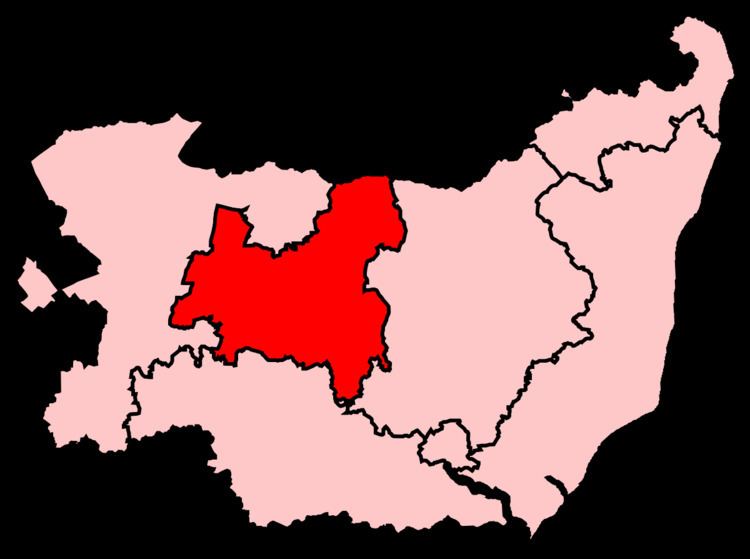Electorate 85,933 (December 2010) Number of members One | Population 113,678 (2011 census) Created 1918 | |
 | ||
Member of parliament | ||
Bury St Edmunds is a constituency in Suffolk centred on the town of Bury St Edmunds that elects a Member of Parliament (MP) to the House of Commons of the Parliament of the United Kingdom. The electorate has elected Conservative Party candidates at the general elections and two by-elections since the Liberal Party victory of 1880, though the Labour Party candidate came 368 votes, and less than 1% short of winning it in 1997, albeit during Tony Blair's famous landslide.
Contents
In terms of election expenses and type of returning officer it has been a county constituency since 1918, before which it was a borough constituency that was created in 1614, returning two MPs to the House of Commons of England until 1707, then to the House of Commons of Great Britain until 1800, and from 1800 to the House of Commons of the United Kingdom. Its representation was reduced to one seat under the Redistribution of Seats Act 1885; it was extended and its type was switched under the Representation of the People Act 1918.
Boundaries
1918-1950: The Municipal Borough of Bury St Edmunds, the Urban District of Newmarket, the Rural Districts of Brandon, Mildenhall, and Thedwastre, and parts of the Rural Districts of Moulton and Thingoe.
1950-1983: The Municipal Borough of Bury St Edmunds, the Urban Districts of Haverhill and Newmarket, and the Rural Districts of Clare, Mildenhall, Thedwastre, and Thingoe.
1983-1997: The Borough of St Edmundsbury wards of Abbeygate, Barningham, Barrow, Chevington, Eastgate, Fornham, Great Barton, Honington, Horringer, Ixworth, Northgate, Pakenham, Risby, Risbygate, Rougham, St Olave's, Sextons, Southgate, Stanton, Westgate, and Whelnetham, and the District of Forest Heath.
1997-2010: The Borough of St Edmundsbury wards of Abbeygate, Eastgate, Fornham, Great Barton, Horringer Court, Northgate, Pakenham, Risbygate, Rougham, St Olave's, Sextons, Southgate, Westgate, and Whelnetham, and the District of Mid Suffolk wards of Badwell Ash, Elmswell, Gislingham, Haughley and Wetherden, Needham Market, Norton, Onehouse, Rattlesden, Rickinghall, Ringshall, Stowmarket Central, Stowmarket North, Stowmarket South, Stowupland, Thurston, Walsham-le-Willows, and Woolpit.
2010–present: The Borough of St Edmundsbury wards of Abbeygate, Eastgate, Fornham, Great Barton, Horringer and Whelnetham, Minden, Moreton Hall, Northgate, Pakenham, Risbygate, Rougham, St Olave's, Southgate, and Westgate, and the District of Mid Suffolk wards of Bacton and Old Newton, Badwell Ash, Elmswell and Norton, Gislingham, Haughley and Wetherden, Needham Market, Onehouse, Rattlesden, Rickinghall and Walsham, Ringshall, Stowmarket Central, Stowmarket North, Stowmarket South, Stowupland, Thurston and Hessett, and Woolpit.
The constituency contains the towns of Bury St Edmunds, Stowmarket and Needham Market. Its boundaries do not match those of the borough of St Edmundsbury, which includes Haverhill (part of West Suffolk constituency), and excludes Stowmarket and Needham Market.
MPs 1660–1885
Two Members
Elections in the 1940s
Following the death of Frank Heilgers on 16 January 1944 a by-election was held on 29 February 1944.
Elections in the 1920s
On Guinness's nomination as Minister of Agriculture a by-election in 1925 was required under the electoral law of the time, which he won.
The Unionist candidate Walter Edward Guinness was elected unopposed in the 1918, 1922 and the 1923 general elections, so there are no votes for these elections.
General Election 1914/15:
Another General Election was required to take place before the end of 1915. The political parties had been making preparations for an election to take place and by the July 1914, the following candidates had been selected;
